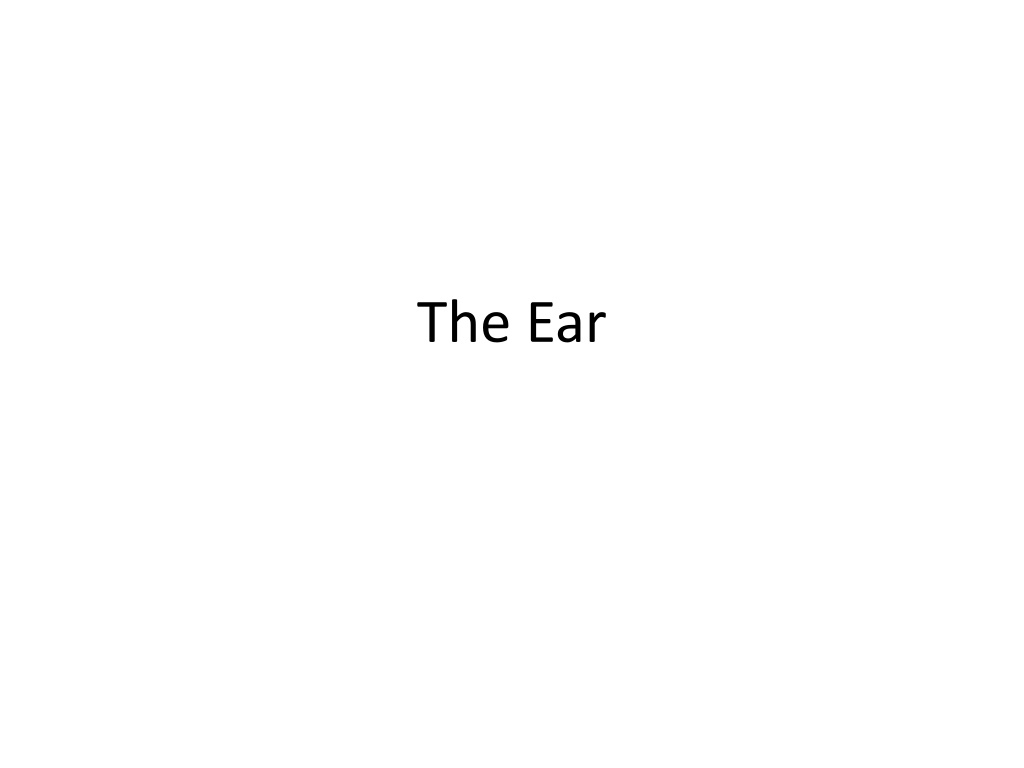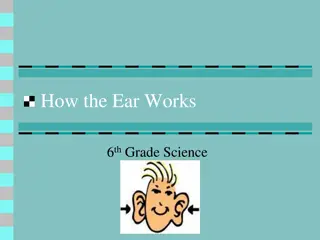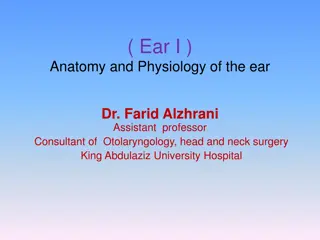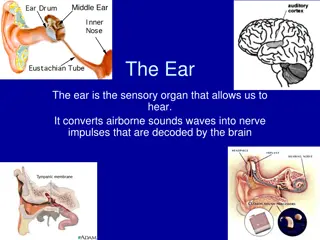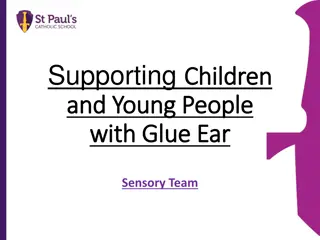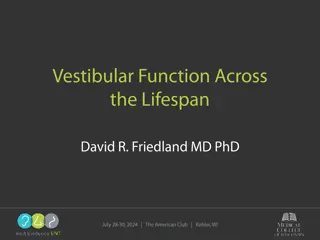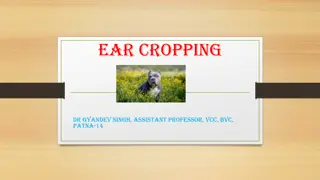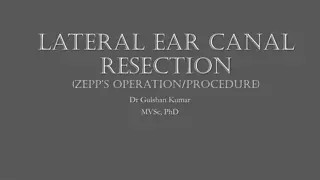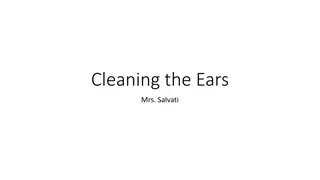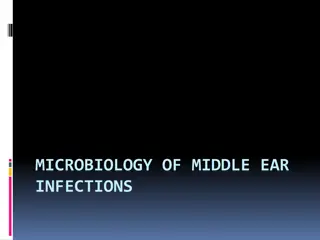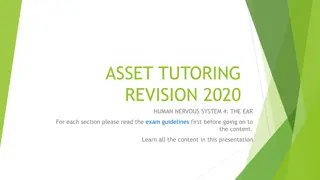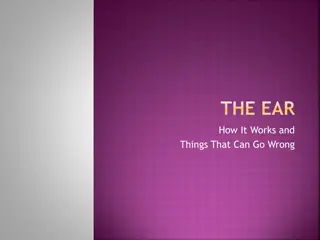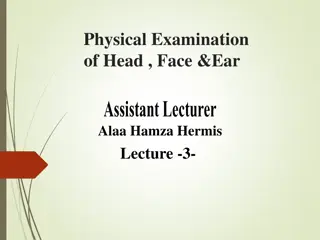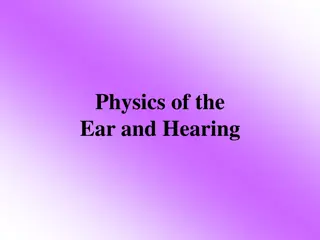Explore the Anatomy of the Ear
Delve into the intricate structures of the human ear, including the stapes, incus, malleus, semicircular canals, auditory nerve, pinna, cochlea, external auditory canal, tympanic membrane, and Eustachian tube. Learn about the functions of each component and how they work together to enable hearing and maintain balance.
Uploaded on Sep 15, 2024 | 0 Views
Download Presentation

Please find below an Image/Link to download the presentation.
The content on the website is provided AS IS for your information and personal use only. It may not be sold, licensed, or shared on other websites without obtaining consent from the author. Download presentation by click this link. If you encounter any issues during the download, it is possible that the publisher has removed the file from their server.
E N D
Presentation Transcript
Stapes (Stirrup) Incus (Anvil) Malleus (Hammer) Semicircular Canals Auditory Nerve Pinna Cochlea External Auditory Canal Tympanic Membrane Eustachian Tube
Pinna (also called the auricle) the visible part of the outer ear. It collects sound and directs it into the outer ear canal
External Auditory Canal the tube through which sound travels to the eardrum.
Tympanic Membrane (Eardrum) thin membrane that vibrates when sound waves reach it.
Eustachian tube a tube that connects the middle ear to the back of the nose; it equalizes the pressure between the middle ear and the air outside.
hammer - (also called the malleus a tiny bone that passes vibrations from the eardrum to the anvil.
anvil - (also called the incus) a tiny bone that passes vibrations from the hammer to the stirrup.
stirrup - (also called the stapes) a tiny, U-shaped bone that passes vibrations from the stirrup to the cochlea.
Cochlea a spiral-shaped, fluid-filled inner ear structure; it is lined with cilia (tiny hairs) that move when vibrated and cause a nerve impulse to form.
Semicircular Canals three loops of fluid-filled tubes that are attached to the cochlea in the inner ear. They help us maintain our sense of balance.
Auditory Nerves these carry electro-chemical signals from the inner ear (the cochlea) to the brain.
7. The movement of these cilia stimulates the nerve cells, and they send signals to the brain via the auditory nerve. 7 5 2. travels to the ear and is collect by the outer ear. 6 6. The fluid inside the cochlea vibrates a series of tiny hairs called cilia, which are attached to auditory nerves. 4. The ear drum vibrates with these sound waves. 1. Something vibrates and creates a sound wave 5. The vibration moves tiny bones in the middle ear. These bones carry vibrations into the inner ear to a fluid- filled tube called the cochlea. 3. Sound moves into the ear canal. When it reaches the end of the ear canal, the sound waves bump up against the eardrum. 8. The brain processes these signals into the sounds we hear 9. the brain identifies those sound vibrations as familiar sounds or words
http://www.amplifon.co.uk/interactive- ear/index.html
Types of hearing loss Hearing loss can be categorized by which part of the auditory system is damaged. There are three basic types of hearing loss: conductive hearing loss, sensorineural hearing loss, and mixed hearing loss.
Conductive hearing loss affects the passage of sound between the ear drum and the inner ear. Conductive hearing loss usually involves a reduction in sound level or the ability to hear faint sounds. This type of hearing loss can often be corrected medically or surgically.
Sensorineural hearing loss damage to the hair cells in the cochlea (this is the sensory hearing organ) or damage to the neural pathways of hearing (nerves). Most of the time, SNHL cannot be medically or surgically corrected. This is the most common type of permanent hearing loss. SNHL reduces the ability to hear faint sounds. Even when speech is loud enough to hear, it may still be unclear or sound muffled.
Mixed hearing loss a combination of conductive and sensorineural hearing loss. This means that there may be damage in the outer or middle ear and in the inner ear (cochlea) or auditory nerve.
How old are your ears? https://www.youtube.com/watch?v=VxcbppCX6 Rk
Hearing Loss simulator https://www.youtube.com/watch?v=TD5E88fFnxE ACTIVITY 1: Hearing Simulations List emotions that you were feeling as you tried to listen to the hearing loss simulations. Did you notice any changes in your body language and/or temperament? What challenges do you think you would face if you had a hearing loss?
ACTIVITY 2: Unfair Spelling Test Were you frustrated as you took the unfair spelling test? If so, describe the challenges you faced taking the test. What would have helped you hear/understand the words better? How would you change your spelling tests for students who are hearing impaired?
Unfair spelling Test http://podcasts.milwaukee.k12.wi.us//blojsom_ resources/meta/805/Unfair%20Spelling%20Test. mp3
Hearing Aids small electronic devices that amplify sound. Hearing aids aren't effective for everyone. Hair cells in the inner ear must pick up the vibrations that the hearing aid sends and convert those vibrations into nerve signals. So, you need to have at least some hair cells in the inner ear for it to work. And, even if some hair cells remain, a hearing aid won't completely restore normal hearing.
Hearing aids are fairly simple devices, consisting of four basic parts: A microphone picks up sound from the environment and converts it into an electrical signal, which it sends to the amplifier. An amplifier increases the volume of the sound and sends it to the receiver. A receiver/speaker changes the electrical signal back into sound and sends it into the ear. Then those impulses are sent to the brain. A battery provides power to the hearing aid.
Cochlear Implants Cochlear implants work better in people with more severe ear damage because they bypass the damaged parts of the ear and send the sound information -- as electrical signals -- directly to the auditory nerve.
Parts of a cochlear implant CI have 2 main parts: the processor-the part outside of the body that picks up sounds the implant-inside the body. Receives signals and sends them to the hearing nerves.
How a cochlear implant works https://www.youtube.com/watch?v=m3Vuxadw nOQ
Cochlear Implants Simulation https://www.youtube.com/watch?v=SpKKYBkJ 9Hw
